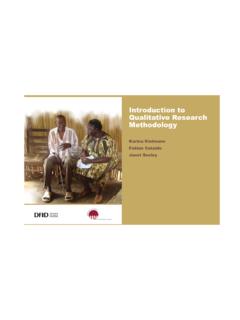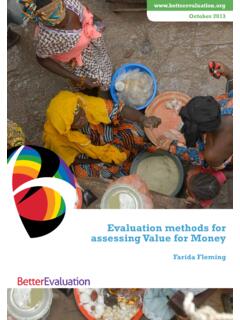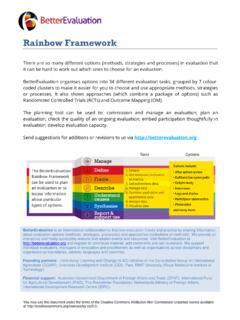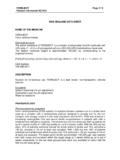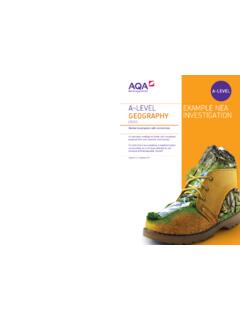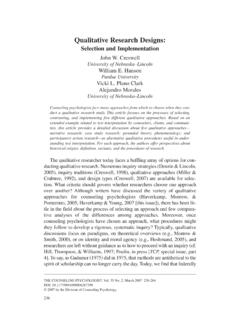Transcription of Analyzing Qualitative Data 4 Thematic coding and …
1 Analyzing Qualitative Data4 Thematic coding and categorizingContributors: Graham R. GibbsPrint Pub. Date: 2007 Print ISBN: 9780761949800 Online ISBN: 9781849208574 DOI: pages: 38-55 This PDF has been generated from SAGE Research Methods. Please note that thepagination of the online version will vary from the pagination of the print UniversityCopyright 2012 SAGE Publications, 2 of 22 Analyzing Qualitative data : 4 Thematic coding andcategorizingSage Research Methods4 Thematic coding and categorizing Codes and coding The mechanics of coding data -driven or concept-driven? What to code Retrieving text from codes Grounded theoryChapter objectivesAfter reading this chapter, you should see the central role of coding in Qualitative analysis; see from the close examination of an example the importance of creatingcodes that are analytic and theoretical and not merely descriptive; and know two techniques that can be used to promote the move from descriptionto analysis: constant comparison and line-by-line and codingCoding is how you define what the data you are Analyzing are about.
2 It involvesidentifying and recording one or more passages of text or other data items such as theparts of pictures that, in some sense, exemplify the same theoretical or descriptive , several passages are identified and they are then linked with a name for thatidea the code. Thus all the text and so on that is about the same thing or exemplifiesthe same thing is coded to the same name . coding is a way of indexing or categorizingthe text in order to establish a framework of Thematic ideas about it (see Box for adiscussion of these terms). coding in this way enables two forms of can retrieve all the text coded with the same label to combine passagesthat are all examples of the same phenomenon, idea, explanation or UniversityCopyright 2012 SAGE Publications, 3 of 22 Analyzing Qualitative data : 4 Thematic coding andcategorizingSage Research MethodsThis form of retrieval is a very useful way of managing or organizing the data ,and enables the researcher to examine the data in a structured can use the list of codes, especially when developed into a hierarchy, toexamine further kinds of analytic questions, such as relationships betweenthe codes (and the text they code) and case-by-case comparisons.
3 This willbe examined in Chapter Code, index, category or theme?When you first come across it, the idea of a code might seem rather probably first think about it in terms of secret codes and ciphers. For others, theassociation with computer code and programming might come to mind. As it is usedhere, codes are neither secretive nor to do with programming. They are simply a way oforganizing your thinking about the text and your research on Qualitative analysis use a variety of terms to talk about codes and such as indices, themes and categories are used. Each reflects an importantaspect of coding . Richie and Lewis prefer the term index as this captures the sensein which codes refer to one or more passages in the text about the same topic in theway that entries in a book index refer to passages in the book (Ritchie et al.)
4 , 2003). Inphenomenological analysis, a term that is used instead of codes is themes (Smith,1995; King, 1998). Again this captures something of the spirit of what is involved inlinking sections of text with Thematic ideas that reveal the person's experience of theworld. Dey (1993) uses category , which indicates another aspect of coding . Theapplication of names to passages of text is not arbitrary, it involves a deliberate andthoughtful process of categorizing the content of the text. coding means recognizingthat not only are there different examples of things in the text but that there are differenttypes of things referred add confusion to this, quantitative researchers also use the term coding whenassigning numbers to survey question answers or categorizing answers to open-endedquestions.
5 The latter is somewhat like Qualitative coding , but is usually done in orderto count the categorized responses, which is not the prime motivation of UniversityCopyright 2012 SAGE Publications, 4 of 22 Analyzing Qualitative data : 4 Thematic coding andcategorizingSage Research MethodsThe structured list of codes and the rules for their application (their definitions) thatresult from Qualitative analysis are sometimes referred to as a coding frame. Again,this is confusing, since quantitative researchers use this to refer to the listing that tellsthem what numeric value to assign to different answers in surveys so that they canbe counted. For that reason I have avoided the term. Others use the term thematicframework (Ritchie et al.)
6 , 2003) or template (King, 1998). Here I just refer to thelist of codes, or the codebook, a term used by many other analysts. Book suggestssomething more weighty than just a list and indeed it is good practice that you shouldkeep more than just a list. The codebook is something that should be kept separatefrom any coded transcripts. It should include not only the current and complete list ofyour codes, arranged hierarchically if appropriate, but also a definition for each alongwith any memos or analytic notes about the coding scheme that you have is easiest using a transcript. It is possible to code directly from an audio orvideo recording or from rough field notes, but it is neither easy to do this nor is it easyto retrieve the sections of recording or notes that have been coded when you needthem.
7 (The exception to this is when you are using CAQDAS and digital video or the software makes it much easier to retrieve the sections of video or audio thatyou have coded.) In fact, a lot of the time, coding is best done with an electronic textfile using dedicated analysis software. I shall examine this in Chapter 9, but here Ishall explain techniques that can be done with a paper transcript. I actually use bothpaper-based and computer-based approaches myself. I find that paper allows me thekinds of creativity, flexibility and ease of access that is important at the early stagesof analysis. I then transfer the coding ideas into the electronic version of the projectin order to continue the analysis.
8 Do not be afraid about using either just paper or justsoftware or both. As long as you make certain preparations (like introducing your datainto the software before you produce printed copy to work on), there is nothing to stopyou moving, when you want to, from paper to the software. Of course, you don't have touse software at all. For most of the last century, those undertaking Qualitative analysisdid not or could not use software. Most of the classic studies using Qualitative researchwere undertaken without electronic UniversityCopyright 2012 SAGE Publications, 5 of 22 Analyzing Qualitative data : 4 Thematic coding andcategorizingSage Research MethodsCode definitionsCodes form a focus for thinking about the text and its interpretation.
9 The actual codedtext is just one aspect of that. For this reason it is important that as early as you can youwrite some notes about each code you develop. In the previous chapter I introducedthe idea of writing memos as an important way of recording the development of youranalytic thinking. A key function of such memos is to note the nature of a code andthe thinking that lies behind it and to explain how the code should be applied or whatkinds of text, images, and so on should be linked to the code. Keeping such a record isimportant for two will help you apply the code in a consistent way. Without having to rereadall the text already coded to this name , you will be able to decide if any newtext should really be coded you are working in a team, it will enable you to share your codes withothers for them to use and, if they have done the same, to use theirs.
10 It isquite likely, if more than one member of the team is coding , that more thanone person will come up with similar coding ideas. Having memos about thecodes will enable you to tell if the codes are, in fact, identical or your code memos in one or more word-processing files (so you can easily editthem or print them out) or use large filing cards to record the details. Typically you willneed to record: The label or name of the code that you have used in marking up and codingthe transcript. Who coded it the name of the researcher (not needed if you are workingalone). The date when the coding was done or changed. Definition of the code a description of the analytic idea it refers to and waysof ensuring that the coding is reliable, that is, carried out in a systematic andconsistent way.

